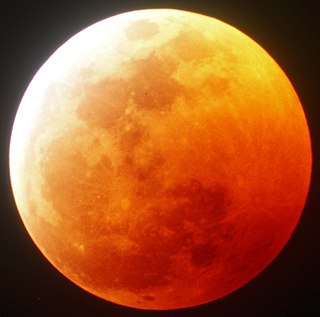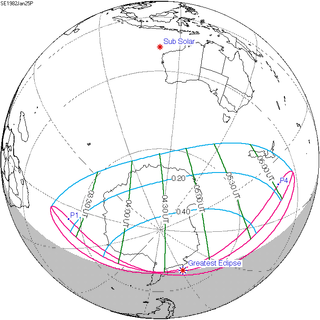
A total lunar eclipse took place on Sunday 9 November 2003, the second of two total lunar eclipses in 2003, the first being on 16 May 2003. It is the first total lunar eclipse of 21st century which happened on a micromoon day. The Moon barely edged into total eclipse for 21 minutes and 58 seconds. With the Moon just 1.78% of its diameter into the Earth's umbral shadow, the Moon may have been quite bright, but even so, this should have been worth seeing. The partial eclipse lasted for 3 hours, 31 minutes and 25 seconds. Occurring only 1.4 days before apogee, the Moon's apparent diameter was 6.4% smaller than average.

A total lunar eclipse took place on Thursday 28 October 2004, the second of two total lunar eclipses in 2004, the first being on 4 May 2004. It was the first lunar eclipse to take place during a World Series game, which when seen from Busch Memorial Stadium in St, Louis, Missouri, provided a surreal sight on the night the Boston Red Sox won their first World Series in 86 years to end the Curse of the Bambino. Occurring 5.6 days before apogee, the Moon's apparent diameter was smaller. The moon was 10.1 days after perigee and 5.6 days before apogee.

A penumbral lunar eclipse took place on Sunday 30 December 2001, the last of three lunar eclipses in 2001. At maximum eclipse, 89.477% of the Moon's disc was partially shaded by the Earth, which caused a slight shadow gradient across its disc; this subtle effect may have been visible to careful observers. No part of the Moon was in complete shadow. The eclipse lasted 4 hours, 4 minutes and 17.7 seconds overall. This lunar eclipse followed the Annular Solar Eclipse on 14 December 2001.

A total lunar eclipse took place on Tuesday 9 January 2001, the first of three lunar eclipses in 2001. A shallow total eclipse saw the Moon in relative darkness for 1 hour 1 minute and 2 seconds. The Moon was 18.89% of its diameter into the Earth's umbral shadow, and totality was observed in all of Europe, Africa, and Asia. The partial eclipse lasted for 3 hours 16 minutes and 19 seconds and was visible in parts of north-eastern North America and Australia. It is the only total eclipse of 2001. It was visible over Asia and Western Australia with the Middle East getting mid eclipse at midnight.

A partial lunar eclipse took place on Monday, March 24, 1997, the first of two lunar eclipses in 1997.

A total lunar eclipse took place on 4 April 2015. It is the former of two total lunar eclipses in 2015, and the third in a tetrad. Other eclipses in the tetrad are those of 15 April 2014, 8 October 2014, and 28 September 2015.
A total lunar eclipse took place at the Moon's descending node of the orbit on Wednesday, February 10, 1971, the first of two total lunar eclipses in 1971. It had an umbral magnitude of 1.30819. The Moon passed through the center of the Earth's shadow. The Moon was plunged into darkness for 1 hour, 22 minutes and 11.4 seconds, in a deep total eclipse which saw the Moon 30.819% of its diameter inside the Earth's umbral shadow. The visual effect of this depends on the state of the Earth's atmosphere, but the Moon may have been stained a deep red colour. The partial eclipse lasted for 3 hours, 44 minutes and 42.9 seconds and in total. Occurring only 2.7 days before apogee, the Moon's apparent diameter was 5.9% smaller than average.
A partial lunar eclipse took place on Saturday, June 25, 1983, the first of two lunar eclipses in 1983 with an umbral eclipse magnitude of 0.33479. A partial lunar eclipse happens when the Earth moves between the Sun and the Full Moon, but they are not precisely aligned. Only part of the Moon's visible surface moves into the dark part of the Earth's shadow. A partial lunar eclipse occurs when the Earth moves between the Sun and Moon but the three celestial bodies do not form a straight line in space. When that happens, a small part of the Moon's surface is covered by the darkest, central part of the Earth's shadow, called the umbra. The rest of the Moon is covered by the outer part of the Earth's shadow called the penumbra. The Earth's shadow on the moon was clearly visible in this eclipse, with 33% of the Moon in shadow; the partial eclipse lasted for 2 hours and 15 minutes.
A total lunar eclipse took place on Friday, October 17, 1986, the second of two total lunar eclipses in 1986, the first being on April 24, 1986. The Moon was plunged into darkness for 1 hour, 13 minutes and 41 seconds, in a deep total eclipse which saw the Moon 24.545% of its diameter inside the Earth's umbral shadow. The visual effect of this depends on the state of the Earth's atmosphere, but the Moon may have been stained a deep red colour. The partial eclipse lasted for 3 hours, 36 minutes and 49.5 seconds in total. The Moon was 5.4 days before apogee, making it 3.3% smaller than average.
A penumbral lunar eclipse took place on Thursday, March 3, 1988, the first of two lunar eclipses in 1988, the second being on August 27, 1988. Earlier sources compute this as a 0.3% partial eclipse lasting under 14 minutes, and newest calculations list it as a penumbral eclipse that never enters the umbral shadow. In a rare total penumbral eclipse, the entire Moon was partially shaded by the Earth, and the shading across the Moon should have been quite visible at maximum eclipse. The penumbral phase lasted for 4 hours, 53 minutes and 50.6 seconds in all, though for most of it, the eclipse was extremely difficult or impossible to see. The Moon was 2.2 days after apogee, making it 6.1% smaller than average.

A partial lunar eclipse occurred on the 16 and 17 July 2019. The Moon was covered 65.31% by the Earth's umbral shadow at maximum eclipse.
A total lunar eclipse will take place on Friday, March 14, 2025, the first of two total lunar eclipses in 2025. The Moon will take place near apogee during this eclipse, making it appear smaller than usual. The second eclipse will take place on 7-8 September 2025, happening near perigee. Occurring only 3.4 days before apogee, the Moon's apparent diameter will be 5.4% smaller than average.
A penumbral lunar eclipse took place on Tuesday, September 27, 1977, the second of two lunar eclipses in 1977. At maximum eclipse, 90.076% of the Moon's disc was partially shaded by the Earth, which caused a slight shadow gradient across its disc; this subtle effect may have been visible to careful observers. No part of the Moon was in complete shadow. The eclipse lasted 4 hours, 17 minutes and 35.5 seconds overall. Occurring 6.2 days before apogee, the Moon's apparent diameter was 2.2% smaller than average.
A total lunar eclipse took place on Tuesday, November 18, 1975, the second of two total lunar eclipses in 1975. A shallow total eclipse saw the Moon in relative darkness for 40 minutes and 11.1 seconds. The Moon was 6.421% of its diameter into the Earth's umbral shadow, and should have been significantly darkened. The partial eclipse lasted for 3 hours, 29 minutes and 2.1 seconds in total. Occurring only 4.9 days after apogee, the Moon's apparent diameter was 4% smaller than average.
A penumbral lunar eclipse took place on Saturday, November 6, 1976, the second of two lunar eclipses in 1976, the first being on May 13. This subtle penumbral eclipse may have been visible to a skilled observer at maximum eclipse. 83.827% of the Moon's disc was partially shaded by the Earth, which caused a gentle shadow gradient across its disc at maximum; the eclipse as a whole lasted 4 hours, 25 minutes and 52.1 seconds. Occurring only 0.3 days after apogee, the Moon's apparent diameter was 6.5% smaller than average.
A partial lunar eclipse took place on Saturday, February 21, 1970. It was the first of two partial lunar eclipses in 1970, the other being on August 17 of the same year. A tiny bite out of the Moon may have been visible at maximum, though just 5% of the Moon was shadowed in a partial eclipse which lasted for 52 minutes and 42 seconds. A shading across the moon from the Earth's penumbral shadow should have been visible at maximum eclipse.

A partial lunar eclipse took place on Monday, June 14, 1965. At maximum eclipse, a small bite out of the Moon should have been visible. The eclipse lasted for 1 hour and 40 minutes, with just 18% of the Moon in shadow at maximum.

A total lunar eclipse will take place on May 6, 2069. The eclipse will be a dark one with the southern tip of the Moon passing through the center of the Earth's shadow. This is the first central eclipse of Saros series 132.

A partial solar eclipse occurred on January 25, 1982. A solar eclipse occurs when the Moon passes between Earth and the Sun, thereby totally or partly obscuring the image of the Sun for a viewer on Earth. A partial solar eclipse occurs in the polar regions of the Earth when the center of the Moon's shadow misses the Earth.

A total lunar eclipse will occur on Wednesday, June 9, 2123, with maximum eclipse at 05:06 UTC. A dramatic total eclipse lasting 106 minutes and 6 seconds will plunge the full Moon into deep darkness, as it passes right through the centre of the Earth's umbral shadow. While the visual effect of a total eclipse is variable, the Moon may be stained a deep orange or red colour at maximum eclipse. This will be a great spectacle for everyone who sees it. The partial eclipse will last for 3 hours and 56 minutes in total. The penumbral eclipse lasts for 6 hours and 14 minutes. Maximum eclipse is at 05:06:28 UT. This will be the longest Total Lunar Eclipse since 16 July 2000, and the longest one until 12 May 2264 and 27 July 3107, though the eclipse on June 19, 2141 will be nearly identical in all aspects. This will also be the longest of the 22nd century and the second longest of the 3rd millennium. The eclipse on June 19, 2141 will be the second longest of the 22nd century and the third longest of the third millennium.






















































